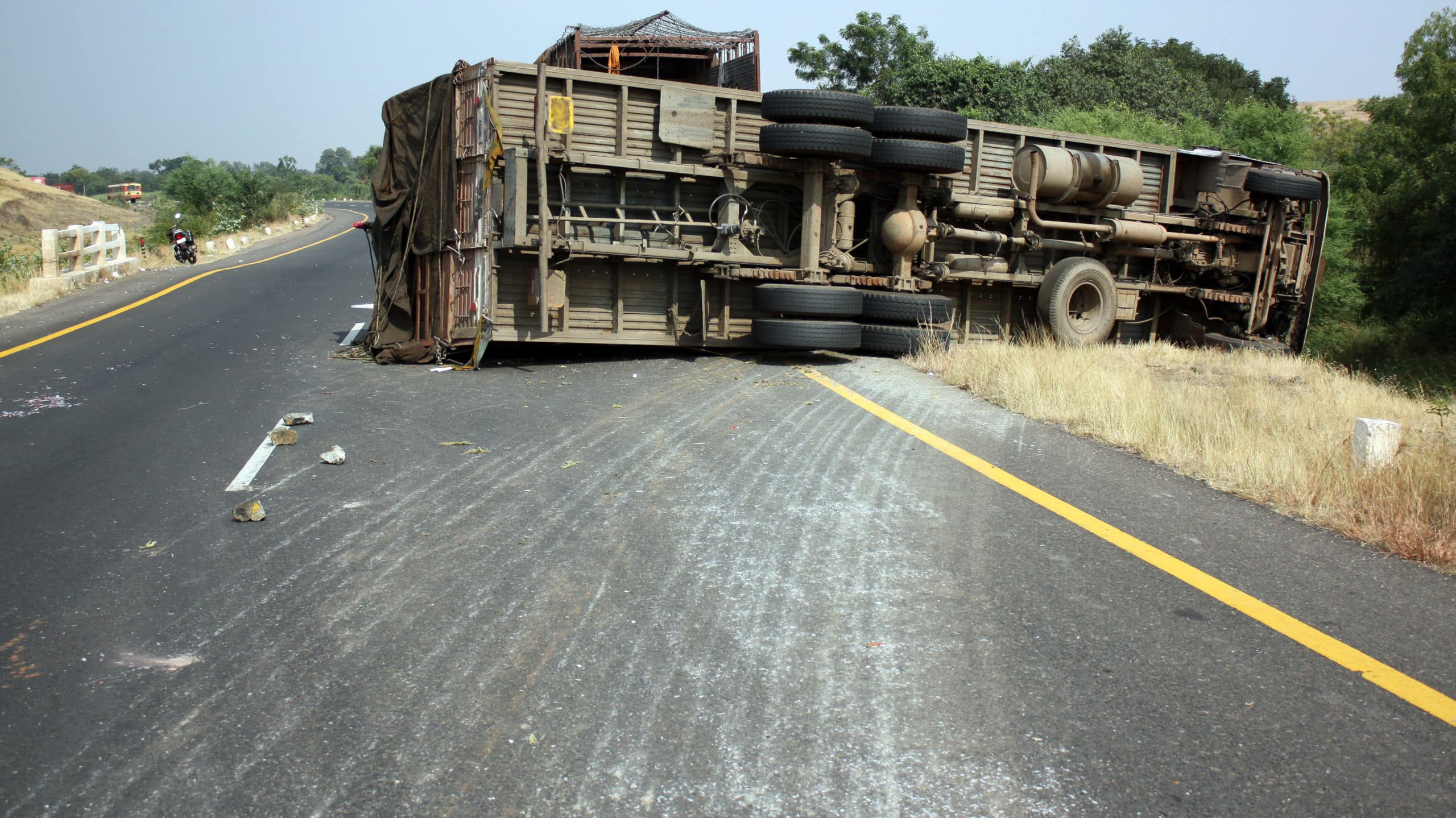Commercial truck driver negligence and truck company negligence can cause serious accidents, resulting in severe injuries and death. Examples of negligent driving include distraction, failure to yield, compliance violations, poorly planned routes, unsecured loads, and driving while intoxicated.
Involved in a big rig crash involving truck accident negligence? We can help. Contact the experienced truck accident lawyers for wrecks caused by negligence at Wilshire Law Firm to start a free case review. We’ve collected over $1 billion for our injured clients and their loved ones. Call us 24/7 at (800) 501-3011.
Table of Contents
- Negligence & Commercial Vehicle Accident Lawsuits
- How a Truck Accident Lawyer Establishes Negligence
- Types of Negligence Common in Truck Accidents
- Blind Spots No Zone
- Compliance Violations
- Disregarding Traffic Signals
- Driver Fatigue
- Driver on Drugs
- Drunk Driving
- Failure to Yield
- Hazardous Bad Road Conditions
- Hit and Run
- Improper Backing Up
- Improper Passing or Turning
- Inattention or Distraction
- Intersection Errors
- Oversized Loads
- Poorly Planned Routes
- Poorly Screened Truck Drivers
- Spillage of Contents
- Tailgating
- Unrealistic Schedules
- Unsafe Lane Changes
- Unsafe Speed
- Unsecured Loads
- Visual Obstructions
- Start a Free Case Review
- More Helpful Resources
- FAQs
How Commercial Truck Negligence Plays a Role in Commercial Vehicle Accidents and Lawsuits
Negligent driving is the failure to take the time and effort to properly prepare for the road and travel to the target destination. When this failure to exercise the proper amount of care happens behind the wheel of a big rig, it’s even more appalling than normal.
A single-axle commercial truck weighs up to 20,000 pounds while a tandem axle semi-truck is 34,000 pounds max [1]. If these trucks are carrying a full load, that’s 80,000 more pounds added to the equation.
The average passenger car, on the other hand, weighs around 3,000 pounds, opening the doors to heavy damage when hit by a semi-truck. Even 6,000-pound SUVs cannot withstand the impact forces that occur in collisions with commercial vehicles [2].
With so much at stake as they slip behind the wheel, truck drivers have the duty to carefully navigate down public roadways while paying close attention to their every move. If they breach that duty, the courts definitely take notice. Negligent actions often result in the truck driver being held responsible for the accident, allowing the other parties to file a lawsuit against the driver and trucking company.

How a Truck Accident Lawyer Establishes Negligence in Injury Cases
A lawsuit is the only way to truly hold a negligent truck driver accountable for causing an accident. When you file your case, you need to hire a truck accident attorney to build your case and represent you in court.
At Wilshire Law Firm, we take building strong injury cases seriously, especially when it comes to establishing negligence. Successfully proving that the commercial truck driver breached their duty to operate their vehicle with care is key in winning your case, after all.
There are four main steps to proving that the truck driver should be deemed at fault for the accident and held responsible for the damages:
- Show that the semi-truck driver had a duty to actively avoid accidents by driving with care
- Prove that the truck driver breached their duty to drive carefully willfully or by mistake
- Link your injuries, property damage, and other losses to the driver’s breach of care
- Describe how the property damages, injuries, and the like resulted in debilitating damages
The best way to do that is by gathering ample evidence and using the data to present a vivid story to the court. All the key officials must be able to visualize the situation and see how the truck driver acted irresponsibly while preparing for the road or while behind the wheel.
To help bring that narrative to life, we may also have witnesses testify to help strengthen your case. Typically, witnesses either saw the accident occur or can testify as an expert on key aspects of the accident.
What Is Negligence?
Negligence is the failure to exercise reasonable care when completing an action. In order to avoid acting negligently, you must practice the same amount of care any other person would in the same situation.
When it comes to trucking accidents, negligence is the absence of care put into preparing the truck and trailer or driving down the road. In all situations, negligence often results in unreasonable risk, making the negligent party responsible for whatever comes from their breach of duty.
Types of Negligence Common in Truck Accidents
Driving large commercial vehicles requires proper preparation and the right level of due diligence or it can all quickly go wrong. Of the many causes of truck accidents, there are many contributors linked to truck driver negligence that include the following.
Blind Spots No Zones
Also known as No Zones, blind spots on large trucks are huge areas around the front, back, and sides of the vehicle where the driver cannot see anything [3]. Cars, trucks, and even large SUVs are pretty much invisible when traveling in those zones.
But that doesn’t mean that truck drivers are not responsible for checking their blind spots before changing lanes, turning, or otherwise maneuvering around. They must confirm that all the areas around their trucks are clear before making their move or they may end up responsible for a serious collision.
Compliance Violations
Compliance violations are an example of both driver and trucking company negligence. These violations range from failing to test for drugs and alcohol to allowing drivers to operate the vehicle on a revoked CDL license [4].
Major compliance violations can result in safety hazards for the large truck driver and their fellow motorists. If a driver doesn’t undergo regular drug testing, for example, they could end up driving while intoxicated and cause an accident.
Disregarding Traffic Signals
Just like other motorists, commercial truck drivers must obey all traffic signals, even when it’s inconvenient or takes too much time. These drivers do not have a free pass to ignore yield signs, stop lights, or the like despite the sheer size and weight of their vehicles.
Disregarding traffic signals can result in a hazardous situation, after all, putting everyone on the road at risk of getting into an accident. If a truck driver fails to stop or otherwise heed the signal, then they’re likely going to end up at-fault if a collision occurs.
Driver Fatigue
Driver fatigue is a serious issue in the commercial trucking world. That’s why the Federal Motor Carrier Safety Administration (FMCSA) put Hours of Service Regulations in place [5].
Under these regulations, large truck drivers can only pilot their vehicles for the set limit before having to take a rest. But it’s not a complete failsafe. Driver fatigue can occur due to many of life’s circumstances, like being sick, having a new baby at home, or simply going to bed too late.
Driver on Drugs
Both prescription and street drugs can cause drivers to feel intoxicated, resulting in an unsafe situation if they get behind the wheel. Intoxication impacts judgment, reaction times, and the overall ability to drive safely.
Despite the risks, drug violations are on the rise in recent years [6]. Commercial truck drivers are testing for marijuana, cocaine, and other street drugs more often than ever before. Over 80,000 drivers have landed in prohibited driving status in 2021, potentially preventing many serious accidents as a result.
Drunk Driving
Drunk driving is a serious problem across the nation, causing more than 11,000 people each year to lose their lives [7]. As with drugs, driving while impaired by alcohol impacts reaction times, judgment, and the ability to pilot a vehicle safely.
The risks are even higher when driving a commercial vehicle, which is why many states, like California, have lowered the blood-alcohol concentration (BAC) limit by half. In that state, large truck drivers with a BAC of over 0.04% are guilty of drunk driving and putting other drivers on the road at serious risk [8].
Failure to Yield
Whether there’s proper signage or not, all drivers must yield at key areas on the roadway to avoid causing an accident. The most common yield points on public roadways are at intersections, roadway junctions, and highway merge lanes.
Commercial truck drivers who do not yield at the appropriate points may enter traffic unsafely, resulting in someone hitting their truck or vice versa. This is one of the more common causes of semi-truck accidents because the large vehicle size can make yielding difficult in some situations.
Hazardous Bad Road Conditions
Truck drivers are not in control of hazardous, bad road conditions, but they are responsible for how they respond to them. If drivers fail to adjust their approach in the face of unfavorable conditions, then they could end up causing an accident.
In most cases, it’s best to call it and get off the road or simply find a different way around. At the very least, commercial truck drivers should significantly reduce their traveling speed and pay even more attention to the road ahead.
Hit and Run
When an accident occurs, all drivers must pull off to the right side of the road and exchange information with the other parties. Commercial truck drivers are bound by this rule, too, or they could end up with a hit-and-run charge on their records.
A hit-and-run is pure negligence because it leaves the other parties potentially without help or the ability to hold the responsible party accountable. In addition, this situation often occurs as a way to conceal other negligent activities, like driving under the influence.
Improper Backing Up
There’s no doubt about it—backing up a commercial vehicle is a challenge in the best of situations. Truck drivers must take the proper amount of care while performing that maneuver if they want to avoid causing an accident.
If they go too fast, fail to check their blind spots, or turn too sharply, their risk of getting into an accident increases considerably. In most cases, it’s best for large truck drivers to avoid backing up altogether if pulling forward is a sound option.
Improper Passing or Turning
Great care must go into the process of turning or passing other vehicles while piloting a large truck, especially when pulling a long trailer. It’s often necessary to make extra wide turns that require careful planning and execution to pull off without incident.
Commercial truck drivers who fail to properly perform those maneuvers may cause a serious or even fatal collision. So, they must take the time to get every step right, ensuring all drivers are on the same page before they make their move.
Inattention or Distraction
More than 70% of commercial truck driving accidents occur while the driver is paying attention to something else besides driving [9]. Texting while driving, changing the radio station, or even reading passing billboards can end up being a potentially deadly distraction.
Staying focused on the road ahead is a top priority for large truck drivers and all their fellow motorists as well. Even just a couple of seconds of inattention or distraction is enough time for traffic to stop ahead or other obstacles to appear.
Intersection Errors
Errors while maneuvering through interactions can result in deadly head-on collisions and other serious accidents. The incidents can occur at intersections with signals, but accidents are much more common at uncontrolled intersections with stop signs, yield signs, or no signs at all [10].
The most common causes of truck accidents in intersections occur due to misjudgments of speed. Inaccurately judging how other drivers will maneuver their vehicles can also result in a collision occurring in intersections.
Oversized Loads
The average commercial truck load weighs up to 80,000 pounds. With a permit, trucking companies can have their drivers carry oversized loads that greatly exceed that limit [11]. In some cases, the load might also be wider than the truck, causing the vehicle to take up two lanes or more.
If any accident occurs, the extra cargo weight and size can greatly increase the severity of the accident and even impact far more vehicles than it would otherwise. For that reason, exceptional care must be put into transporting oversized loads.
Poorly Planned Routes
Commercial trucks cannot safely maneuver down all routes. Twisty roadways, narrow lanes, and other challenges can result in the truck getting stuck, jackknifing, or having to back up down the way they came.
Trucking companies and their drivers must properly plan the routes to avoid that situation and help keep everyone safe. Poor planning is negligence, for sure, then since it’s highly preventable with a little extra forethought.
Poorly Screened Truck Drivers
Trucking companies must properly vet their drivers through the FMCSA Pre-Employment Screening Program to only put the best of the best behind the wheel [12]. Just having a current CDL is not enough to show that the driver has what it takes to safely pilot a large vehicle.
Without a solid screening process, companies may hire drivers with bad driving records, a history of drug and alcohol abuse, and other red flags. The trucking company may end up being deemed negligent, along with the driver if they failed to disclose their problematic history.
Spillage of Contents
Spillage of contents typically occurs if the load does not get properly put on the truck and secured. Failure of ratchet straps, cargo nets, and other tie-downs can also cause the cargo to spill out onto the roadway and cause a collision.
Everyone from the driver, warehouse workers, and trucking company may be on the hook for negligence when the contents of the load spills out of the truck. The negligence claims may increase even more if the driver did not stop to handle the spillage.
Tailgating
Tailgating, or following too close, is always a bad idea while driving a large truck. At up to 34,000 pounds on their own, these trucks stop much slower than other vehicles, resulting in the need for additional space from the vehicle ahead.
Large truck drivers have to stay on their toes to avoid tailgating. If any vehicles cut in front of their truck, they must slow down as deemed appropriate to keep the right amount of space open ahead.
Unrealistic Schedules
Trucking companies must stay realistic while creating delivery schedules for their drivers. Putting too many stops in a strict timeline can result in truck drivers cutting corners and taking unnecessary risks.
When faced with unrealistic schedules, commercial truck drivers must push back to ensure their safety and avoid acting negligently. They need to speak with dispatch to get the schedules changed or simply drive their routes safely without worrying about the timeline.
Unsafe Lane Changes
Unsafe lane changes are among the most common causes of truck accidents, especially on packed highways. Due to the large no zones around the truck, it’s difficult to see other vehicles in adjacent lanes.
Truck drivers must confirm that the lane is clear anyway or they may end up negligently causing a severe accident. If they just flip on their blinker, count to 10, and hope for the best, they’re putting themselves and all their fellow motorists at serious risk.
Unsafe Speed
While piloting commercial trucks, drivers must pay close attention to their speed to avoid going above the speed limit or too fast for the current conditions. In addition, many states have a lower speed limit for commercial trucks, ensuring they can safely take corners at speed.
In certain areas, the highway speed limit might be 70 MPH for passenger vehicles, but commercial trucks have to go 60 MPH instead [13]. If truck drivers go as fast as everyone else, they could fail to maneuver through the bends, potentially resulting in a rollover collision.
Unsecured Loads
Improperly securing a load is a serious crime in most states, and for good reason. Unsecured cargo has the potential to fall off the truck and hit nearby vehicles, block the roadway, and create other hazards.
Furthermore, unsecured loads can affect the weight distribution in a commercial vehicle, causing it to tip over while turning or changing lanes. Leaving loads unsecured is 100% negligent, potentially leaving the driver, warehouse crew, and trucking company responsible for any accidents that occur.
Visual Obstructions
Even while moving large loads, commercial truck drivers need to ensure their visual field remains unobstructed. Otherwise, they won’t be able to see other vehicles, bicyclists, or pedestrians on or near the road.
When traveling with oversized loads, drivers must have a crew available to help open up their visual field while warning traffic about the hazards. These crew members are responsible for relaying info about hazards that may be difficult for the driver to spot on their own.
Do Not Ignore Truck Driver Negligence
Due to their large size and weight, semi-trucks and other heavy-duty commercial trucks hit other vehicles with much more force than in passenger car accidents. The resulting damage usually proves devastating for the other drivers, often leaving them dealing with hospitalizations, totaled vehicles, and even the loss of life.
When that occurs, negligent truck drivers must be held accountable for their actions—and we’re here to help. At Wilshire Law Firm, we have the knowledge and skills needed to help you seek justice and recoup your losses. Here’s a look at what you need to know about accidents caused by commercial truck negligence.
Start a Free Case Review with a Law Firm for Truck Accidents Caused by Negligence
Were you involved in an accident caused by a commercial truck driver? If so, you need help from a truck accident lawyer for wrecks caused by negligence. At Wilshire Law Firm, we make it easy to get the legal representation you deserve.
All you have to do is give us a call at (800) 501-3011 to schedule your free case review.
The case review process gives us a chance to hear your story and offer guidance on all your options. By the end of the meeting, you’ll have all the info you need to make a great decision on how to proceed. Although getting legal representation can help you seek justice and compensation for your damages, it’s not the right move for everyone. Only you can make that decision.
If you’d like to move forward with your case, we’ll start building your case by gathering evidence and meeting with witnesses. We will provide our full support through every stage of the process to keep stress to a minimum while helping you understand what to expect.
More Helpful Resources from Wilshire Law Firm
- Personal Injury FAQ
- Truck Accident Statistics – Findings
- Driving Home for the Holidays? Winter Driving Tips
- Hit by a Truck? Here’s Our Semi-Truck Accident Guide
- Medical Glossary for Personal Injury Victims in California
- Drunk Driving in Summer: What to Do If You Get Hit By a DUI Driver
- Spinal Cord Injury Resources in California
Frequently Asked Questions About Commercial Truck Negligence
What are the most common types of fatal truck accidents?
Head-on collisions are the most common type of fatal truck accidents, followed by rear-end collisions [14]. Other serious large truck collisions are side impacts, rollovers, and jackknifes. People in passenger vehicles fare the worst when the front of their car, truck, or van gets hit by a commercial truck.
Why are trucking accidents a serious issue?
Commercial truck accidents are a serious issue due to the sheer vulnerability of the other vehicles on the road. Large trucks weigh up to 30 times more than the average vehicle, resulting in serious, if not fatal, injuries. Commercial vehicles may pose an additional hazard as well if they’re carrying large loads or toxic chemicals.
Do truck drivers make mistakes?
Driver error or negligence accounts for 83% of the large truck accidents that happen each year [15]. Truck drivers are professionals, but that doesn’t mean they don’t make mistakes. Vehicle malfunctions, like brake failures, come in second, causing up to 10% of the collisions. The remaining accidents occur due to environmental factors, including potholes.











